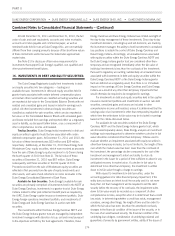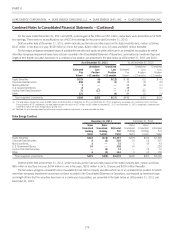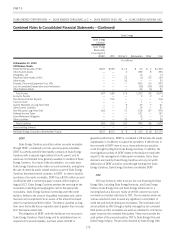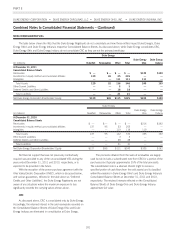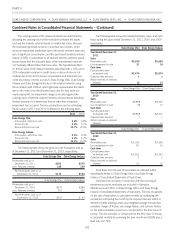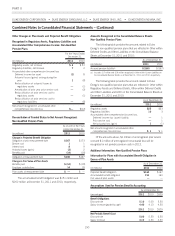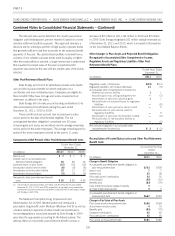Duke Energy 2011 Annual Report Download - page 203
Download and view the complete annual report
Please find page 203 of the 2011 Duke Energy annual report below. You can navigate through the pages in the report by either clicking on the pages listed below, or by using the keyword search tool below to find specific information within the annual report.
PART II
DUKE ENERGY CORPORATION •DUKE ENERGY CAROLINAS, LLC •DUKE ENERGY OHIO, INC. •DUKE ENERGY INDIANA, INC.
Combined Notes to Consolidated Financial Statements – (Continued)
DukeNet.
In 2010, Duke Energy sold a 50% ownership interest in
DukeNet to Alinda. The sale resulted in DukeNet becoming a joint
venture with Duke Energy and Alinda each owning a 50% interest.
In connection with the formation of the new DukeNet joint venture, a
five-year, $150 million senior secured credit facility was executed
with a syndicate of ten external financial institutions. This credit
facility is non-recourse to Duke Energy. DukeNet is considered a VIE
because it has entered into certain contractual arrangements that
provide DukeNet with additional forms of subordinated financial
support. The most significant activities that impact DukeNet’s
economic performance relate to its business development and fiber
optic capacity marketing and management activities. The power to
direct these activities is jointly and equally shared by Duke Energy
and Alinda. As a result, Duke Energy does not consolidate the
DukeNet joint venture. Accordingly, DukeNet is a non-consolidated
VIE that is reported as an equity method investment.
Unless consent by Duke Energy is given otherwise, Duke Energy
and its subsidiaries have no requirement to provide liquidity,
purchase the assets of DukeNet, or guarantee performance.
Renewables.
Duke Energy has investments in various entities that generate
electricity through the use of renewable energy technology. Some of
these entities, which were part of the Catamount acquisition, are VIEs
which are not consolidated due to the joint ownership of the entities
when they were created and the power to direct and control key
activities is shared jointly Instead, Duke Energy’s investment is
recorded under the equity method of accounting. These entities are
VIEs due to power purchase agreements with terms that approximate
the expected life of the project. These fixed price agreements
effectively transfer the commodity price risk to the buyer of the power.
Other.
Duke Energy has investments in various other entities that are
VIEs which are not consolidated. The most significant of these
investments is Duke Energy Ohio’s 9% ownership interest in OVEC.
Through its ownership interest in OVEC, Duke Energy Ohio has a
contractual arrangement through June 2040 to buy power from
OVEC’s power plants. The proceeds from the sale of power by OVEC
to its power purchase agreement counterparties, including Duke
Energy Ohio, are designed to be sufficient for OVEC to meet its
operating expenses, fixed costs, debt amortization and interest
expense, as well as earn a return on equity. Accordingly, the value of
this contract is subject to variability due to fluctuations in power
prices and changes in OVEC’s costs of business, including costs
associated with its 2,256 megawatts of coal-fired generation
capacity. As discussed in Note 5, the proposed rulemaking on
cooling water intake structures, utility boiler MACT, CSAPR and CCP’s
could increase the costs of OVEC which would be passed through to
Duke Energy Ohio. The initial carrying value of this contract was
recorded as an intangible asset when Duke Energy acquired Cinergy
in April 2006.
In addition, the company has guaranteed the performance of
certain entities in which the company no longer has an equity
interest. As a result, the company has a variable interest in certain
other VIEs that are non-consolidated.
18. EARNINGS PER SHARE
Basic Earnings Per Share (EPS) is computed by dividing net
income attributable to Duke Energy common shareholders, adjusted
for distributed and undistributed earnings allocated to participating
securities, by the weighted-average number of common shares
outstanding during the period. Diluted EPS is computed by dividing
net income attributable to Duke Energy common shareholders, as
adjusted for distributed and undistributed earnings allocated to
participating securities, by the diluted weighted-average number of
common shares outstanding during the period. Diluted EPS reflects
the potential dilution that could occur if securities or other agreements
to issue common stock, such as stock options, phantom shares and
stock-based performance unit awards were exercised or settled.
183



